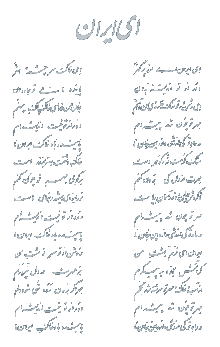This is an old revision of this page, as edited by Monkbot (talk | contribs) at 22:39, 25 October 2024 (Task 20: replace {lang-??} templates with {langx|??} ‹See Tfd› (Replaced 1);). The present address (URL) is a permanent link to this revision, which may differ significantly from the current revision.
Revision as of 22:39, 25 October 2024 by Monkbot (talk | contribs) (Task 20: replace {lang-??} templates with {langx|??} ‹See Tfd› (Replaced 1);)(diff) ← Previous revision | Latest revision (diff) | Newer revision → (diff) Iranian patriotic song
| English: 'O Iran' | |
|---|---|
| ای ایران | |
 Sheet music Sheet music | |
Unofficial anthem of Iran Former national anthem of the Interim Government of Iran | |
| Lyrics | Hossein Gol-e-Golab, 1944 |
| Music | Ruhollah Khaleqi |
| Adopted | 1979 |
| Relinquished | 1979 |
| Audio sample | |
"Ey Irān" (Persian: ای ایران, lit. 'O Iran!', pronounced [ʔej ʔiːˈɹɒːn]) is an Iranian patriotic song that serves as the country's unofficial national anthem. The music was composed by Ruhollah Khaleqi, and the lyrics were written by Hossein Gol-e-Golab. This anthem was first performed by Gholam-Hossein Banan.
History

The song's history dates back to World War II. In September 1941, Allied forces occupied Iran following an Anglo-Soviet invasion that overthrew Reza Shah. Hossein Gol-e-Golab was inspired to write a poem on Iranian nationalism when he saw Allied flags waving from an Iranian military barracks in Tehran. One day, when visiting Tehran, Gol-e-Golab witnessed a heated conversation between a British soldier and an Iranian officer. When Gol-e-Golab recounted the incident, he wanted to write a poem to keep Iran and the Iranian spirit alive in it. Khaleqi decided to compose the song and Banan would sing the poem.
Gol-e-Golab was inspired to write this song by his patriotism. He was quoted as saying:
In 1944, the footsteps of the invading armies in the streets were enough to rattle any patriot and inspired me to write this anthem. Professor Ruhollah Khaleqi wrote the music and despite all the political opposition, it found its way into the heart and soul of the people.
"Ey Irān" served as the country's de facto national anthem for a brief period with the establishment of Iran's interim government following the Iranian Revolution in 1979.
Performances
Its first performance was held for two consecutive nights on 27 October 1944 in the military primary school, performed by Banan on Istanbul Street. "Ey Irān" garnered a lot of popularity that listeners demanded its repetition; thus, it was renewed three times. The reception and impact of this anthem caused the then minister of culture to invite the musicians to the Sound Broadcasting Center to record a page of it and broadcast it daily on Radio Tehran.
After the Revolution of 1979, several people were imprisoned for collaborating in the preparation of this anthem, and singing it was considered a crime, but after a while, it was used to inspire soldiers in the Iran–Iraq War.
In 1990, Golnush Khaleqi, the daughter of Ruhollah Khaleghi, who was in Tehran for the 25th anniversary of her father's death, re-arranged the anthem for orchestra, solo and group singing, which was released on the album May Nab by Sorush Publications. The monologue in this version is performed by Rashid Vatandust.
Lyrics

Problems playing this file? See media help.

Problems playing this file? See media help.
Persian original
| Perso-Arabic script | Latin script | IPA transcription |
|---|---|---|
|
ای ایران ای مرز پرگهر |
Ey Irān ey marze por gohar |
|
| English translation |
|---|
|
O Iran, the land of gems abound, |
See also
References
- EY IRĀN Encyclopædia Iranica
- "Ey Iran". YouTube.
- Akbarzadeh, Pejman (12 November 2015). "داستان آفرینش "ای ایران" و ماجراهای دیگر در گفتوگو با گلنوش خالقی، دختر روح الله خالقی". BBC News (in Persian). Retrieved 6 July 2020.
- Hoseyni Dehkordi, Morteza; Loloi, Parvin. "EY IRĀN". Encyclopædia Iranica. Retrieved 6 July 2020.
- ""روزنامه شرق (1389/09/07): چگونه سرود ای ایران خلق شد"". Magiran (in Persian).
- ""چگونه "ای ایران" خلق شد؟ / مثلت طلایی بنان، خالقی و گلگلاب چه کردند؟"". Tabnak (in Persian). Retrieved 6 July 2020.
- ""استاد گل گلاب"". Aftabir. December 2007. Retrieved 6 July 2020.
- Akbarzadeh, Peyman. "یکصدمین سال تولد روح الله خالقی در رادیو زمانه". Zamaaneh. Retrieved 6 July 2020.
- اى ايران Persian DNA.
"Ey IRAN, Ey Marze Por Gohar, ...
The Greatest Iranian National Anthem" - سرود ای ایران. Persian Arts & Cultural Communities. 15 February 2018.
- "ای ایران". book.iranseda.ir.
- https://www.daryadadvar.com/tag/ای-ایران/ ای ایران
"Ey Iran, Norooz 1387
Iran Heritage Foundation (IHF)
Piano: Tara Kamangar
Flute: Susan McCarthy"
London (2007).
External links
- Ey Irân, Ruhollâh Xâleqi (music), Hossein Golgolâb (lyrics), Golnuš Xâleqi (arrangement, 1991)
- Thousands of Persians sing EY IRÂN in the Nôruz Concert, Oberhausen Arena, March 2014 (VIDEO)
- Original version of EY IRÂN anthem with the complete lyrics in Persian
- English translation
- Ey Irân, Ey Irân Video by Daryâ Dâdvar 2007.
- Ey Irân performed by Zoroastrian Gatha Group, MPEG audio.
| National symbols of Iran | |
|---|---|
| Flag | The Three-Color Flag |
| Emblems |
|
| Anthems |
|
| National anthems of Iran | |
|---|---|
|
| Anthems of Asia | |||||||||||||||||||
|---|---|---|---|---|---|---|---|---|---|---|---|---|---|---|---|---|---|---|---|
| National |
| ||||||||||||||||||
| States with limited recognition | |||||||||||||||||||
| Regional |
| ||||||||||||||||||
| In exile/ disputed | |||||||||||||||||||
| Organisations | |||||||||||||||||||
| Former |
| ||||||||||||||||||